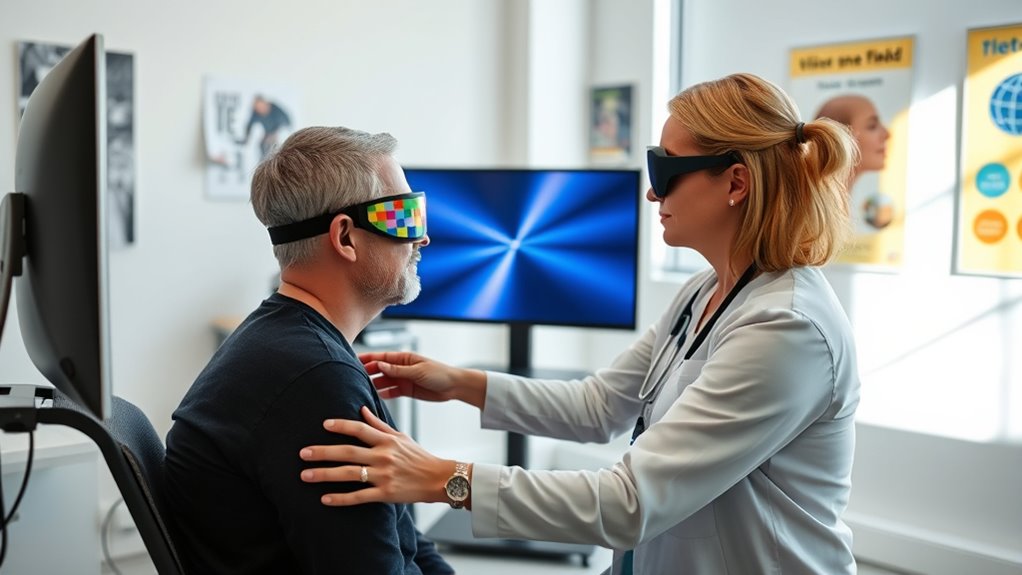Vision neglect can be improved with various techniques. You can practice visual scanning exercises, actively exploring both sides of your environment or using computer-based tasks with real-time feedback. Prism adaptation therapy uses special glasses to retrain your brain, while neurostimulation methods like TMS and tDCS target specific brain areas. Virtual and augmented reality offer immersive, multisensory exercises. Exploring natural elements and multisensory approaches further enhances recovery. If you want detailed strategies, continue exploring how these techniques work together.
Key Takeaways
- Utilize visual scanning exercises and motor-based tasks to enhance awareness of neglected visual fields.
- Apply prism adaptation therapy and neurostimulation techniques like TMS or tDCS to promote neural plasticity.
- Incorporate computer-based training and virtual reality for engaging, personalized attention and scanning exercises.
- Use multisensory therapies involving natural elements and calming activities to improve attention and emotional well-being.
- Combine targeted exercises with technological and multisensory approaches for comprehensive vision neglect rehabilitation.
Traditional Visual Scanning Exercises
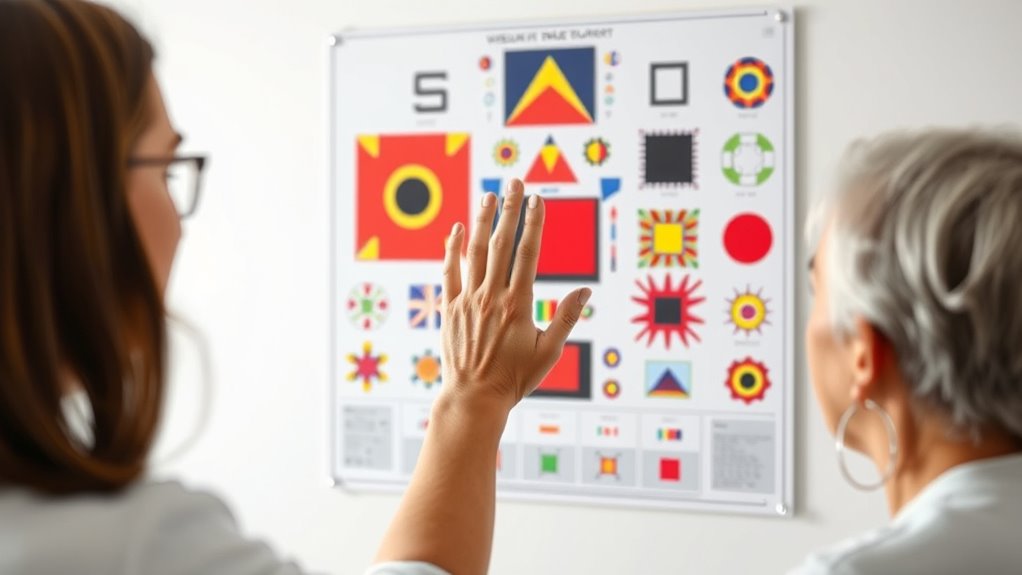
Traditional visual scanning exercises are fundamental tools for rehabilitating vision neglect. You actively engage your eyes to explore the neglected side by systematically scanning the environment. Start by focusing on a fixed point and then slowly move your gaze across the space, ensuring you cover both sides. Use simple tasks, like following a line or tracing shapes, to train your visual attention. Consistency is key; practicing daily helps reinforce neural pathways and improves awareness of the neglected field. You might also incorporate reading exercises, where you consciously scan each line from left to right. These exercises help rebuild your ability to attend to stimuli on the affected side, gradually increasing your visual awareness and reducing neglect. Regular practice fosters better visual exploration and functional independence. Incorporating visual field awareness techniques can further enhance the effectiveness of these exercises, especially when combined with neuroplasticity principles. Additionally, incorporating contrast sensitivity training can help improve detection of subtle stimuli in the neglected area.
Prism Adaptation Therapy
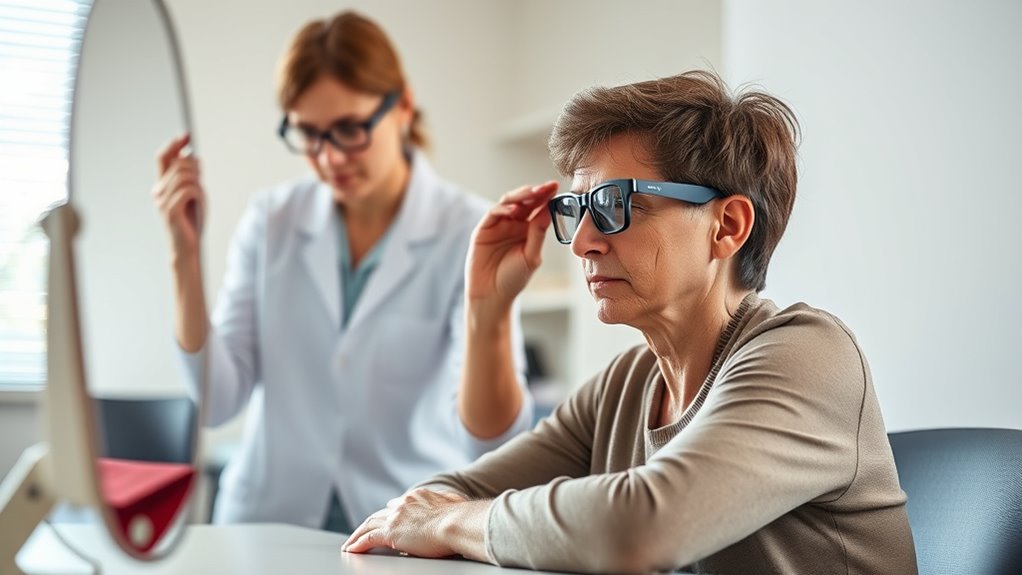
Prism adaptation involves using specialized glasses to shift your visual field and retrain your brain. You’ll learn how to implement specific techniques to help improve awareness of your neglected side. Understanding how these adjustments work is key to effective therapy and better rehabilitation outcomes.
Understanding Prism Adaptation
Understanding prism adaptation involves recognizing how the brain adjusts when exposed to visual shifts caused by prism glasses. When you wear prisms, your visual field shifts, and your brain works to compensate for this change. This process helps restore normal perception and coordination over time. During adaptation, your brain updates its internal map of space, improving your ability to reach and navigate accurately.
Key aspects include:
- Sensorimotor realignment: Your brain recalibrates eye-hand coordination.
- Neural plasticity: It involves changes in neural pathways supporting visual processing.
- Behavioral adjustments: You may notice improved accuracy in tasks like pointing or reaching.
This understanding is fundamental for applying prism adaptation effectively in vision neglect rehabilitation.
Implementing Therapy Techniques
Implementing prism adaptation therapy involves several practical steps to maximize its effectiveness for vision neglect patients. First, you’ll need to determine the appropriate prism strength based on the patient’s severity. Attach the prism glasses securely and ensure comfort during sessions. You should start with short, daily sessions—typically 10 to 15 minutes—and gradually increase as the patient adapts. During therapy, instruct the patient to perform visual tasks like pointing or reaching towards targets while wearing the prisms. It’s essential to monitor progress regularly and adjust the prism angle if needed. Provide clear instructions and support to help the patient incorporate the therapy into daily activities. Consistency and patient engagement are key to achieving meaningful improvements in visual attention and spatial awareness.
Visual Feedback and Computer-Based Training
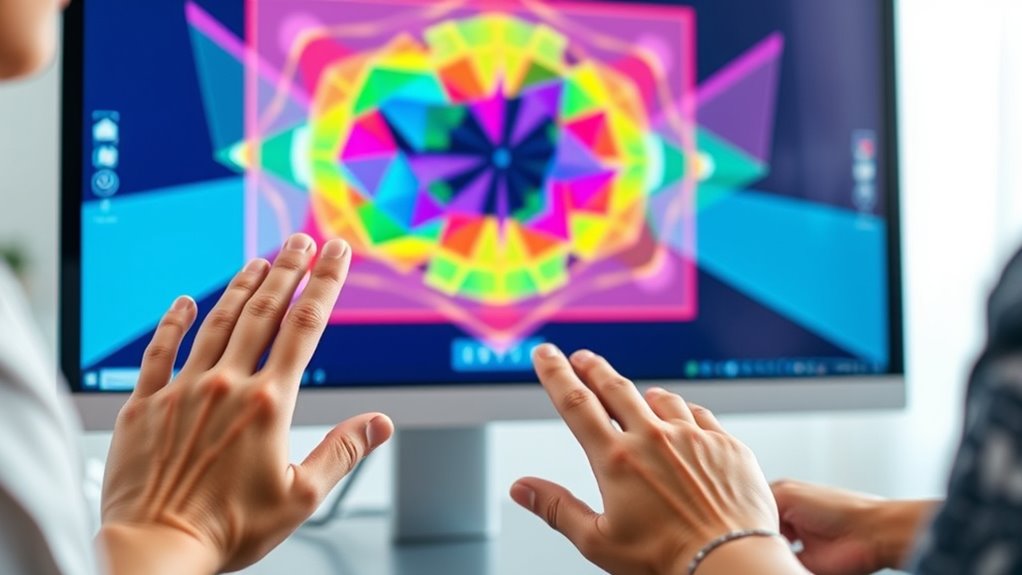
Digital tools for therapy offer innovative ways to improve your visual awareness. With computer-based training, you can receive immediate feedback that helps you recognize and correct neglect behaviors. These techniques make rehabilitation more engaging and tailored to your specific needs. Incorporating data-driven strategies can further enhance the effectiveness of your recovery process.
Digital Tools for Therapy
Digital tools have revolutionized the way therapists approach vision neglect rehabilitation through visual feedback and computer-based training. These tools provide real-time data, making sessions more interactive and personalized. You can use software that tracks eye movements, helping you identify areas of neglect more accurately. Computer programs often include engaging exercises designed to stimulate awareness in neglected visual fields.
Some key features include:
- Interactive visual tasks that adapt to your progress
- Immediate feedback to reinforce correct responses
- Data tracking to monitor improvements over time
These digital solutions increase motivation, enhance engagement, and allow for more targeted interventions. As a result, they make therapy more efficient, accessible, and tailored to your specific needs.
Enhancing Visual Awareness
Enhancing visual awareness in vision neglect therapy relies heavily on visual feedback and computer-based training, which actively engage you in your recovery process. These techniques help you recognize neglected areas by providing immediate, clear responses to your actions. Computer programs can present targets or obstacles on screens, prompting you to focus on the neglected side. As you respond, the system offers real-time feedback, reinforcing awareness and encouraging attentional shifts. This interactive approach keeps you motivated and allows for tailored difficulty levels suited to your progress. By repeatedly practicing these tasks, you strengthen neural pathways responsible for visual attention. Over time, such training can markedly improve your ability to notice and respond to stimuli on your neglected side, enhancing overall visual awareness.
Limb Activation and Motor-Based Approaches
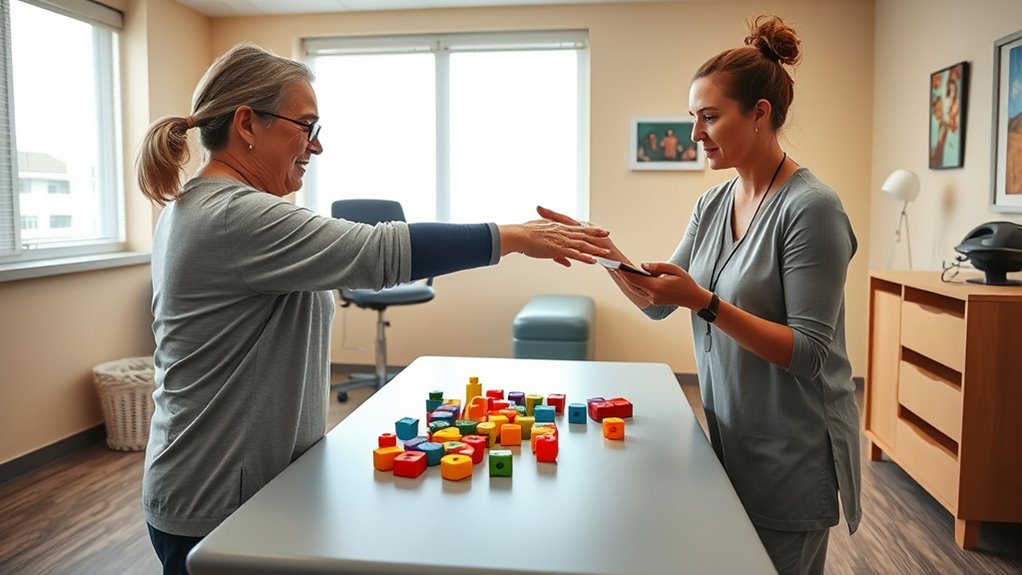
Limb activation and motor-based approaches are essential strategies in rehabilitating patients with vision neglect, as they directly engage the affected side to improve awareness and functional recovery. By encouraging intentional movements, you stimulate neural pathways that promote attention to the neglected space. These approaches often involve tasks like limb movements, reaching exercises, and sustained motor activity. Incorporating techniques such as: – Using the affected limb to perform goal-directed movements – Incorporating bilateral tasks to enhance neural connectivity – Repetitive motor training to reinforce awareness of the neglected side Engaging the motor system helps rewire brain circuits, increasing spatial awareness and improving daily function. Additionally, motor learning principles can further enhance the effectiveness of these interventions by promoting skill retention and transfer to real-world activities. Incorporating neuroplasticity concepts into therapy can optimize recovery outcomes by encouraging the brain’s ability to adapt and reorganize itself, especially through targeted exercises that focus on specific neural pathways.
Virtual Reality and Augmented Reality Interventions
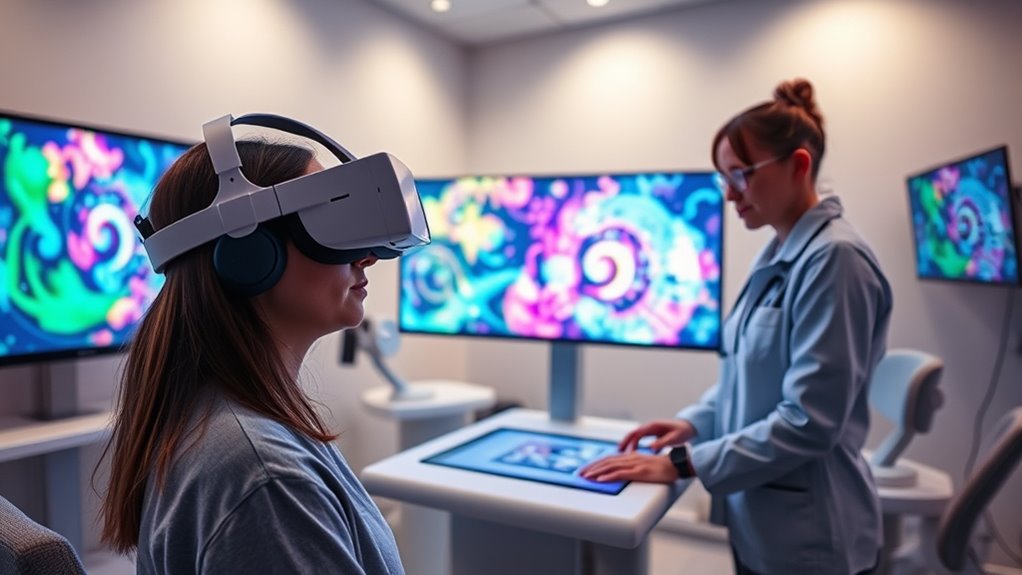
Building on motor-based approaches, virtual reality (VR) and augmented reality (AR) interventions offer innovative ways to address vision neglect. These technologies create immersive environments that simulate real-world tasks, allowing you to practice scanning and attention toward your neglected field. These approaches can be particularly effective because they provide a multisensory stimulation that engages multiple senses simultaneously, promoting more robust neural reorganization. VR and AR can enhance engagement, providing immediate feedback and adjustable difficulty levels tailored to your progress. By integrating visual, auditory, and sometimes tactile cues, these interventions help retrain your brain to attend to stimuli on the neglected side. They also enable safe, controlled practice outside clinical settings, promoting consistency and motivation. As you interact with dynamic, multisensory scenarios, VR and AR facilitate targeted rehabilitation that can lead to improved awareness and functional independence in daily activities. Incorporating elements like natural materials can further support a calming and effective therapeutic environment. Additionally, the use of self-watering plant pots in therapeutic settings can provide a calming, multisensory activity that encourages attention and engagement.
Neurostimulation Techniques
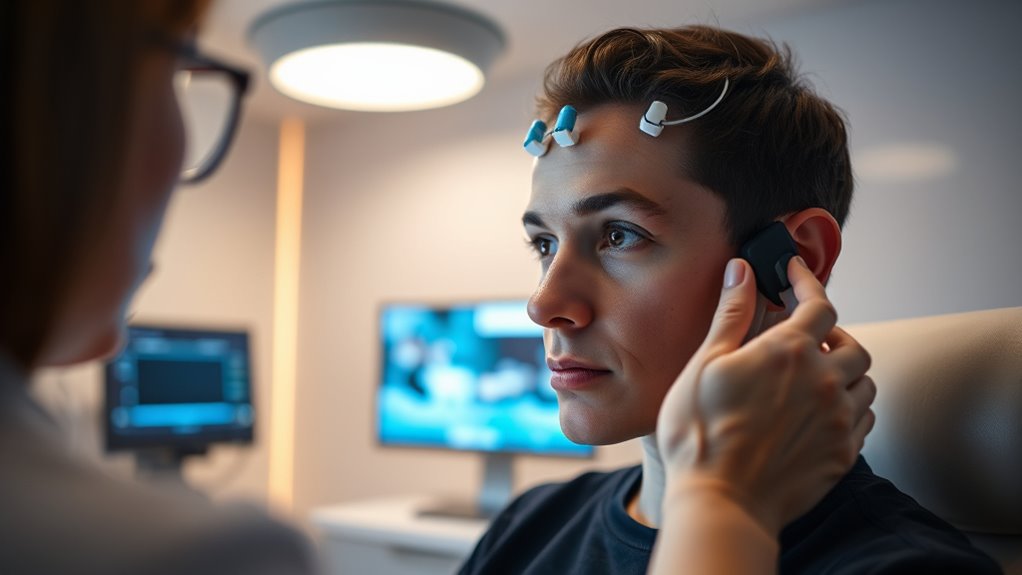
Neurostimulation techniques have emerged as promising approaches to improve vision neglect by directly modulating brain activity. These methods target specific neural pathways to enhance awareness of neglected visual fields. Transcranial magnetic stimulation (TMS) uses magnetic pulses to activate or inhibit areas in the parietal lobe, improving spatial attention. Transcranial direct current stimulation (tDCS) applies low electrical currents to adjust cortical excitability, aiding recovery. Additionally, vagus nerve stimulation (VNS) can promote neuroplasticity by stimulating the vagus nerve, which influences brain networks involved in attention. You might experience benefits such as cultural intelligence improved visual awareness in neglected areas, enhanced neural connectivity, and faster rehabilitation progress. These techniques offer non-invasive options to complement traditional therapies by leveraging neuroplasticity to facilitate functional recovery. Moreover, understanding the mechanisms of brain modulation can help optimize treatment protocols for better outcomes. Incorporating knowledge of regional brain functions can further refine targeted stimulation approaches for more precise rehabilitation, and ongoing research continues to explore the impact of neural network reorganization on recovery processes.
Frequently Asked Questions
How Long Does It Typically Take to See Improvements With These Therapies?
You’re wondering how long it takes to notice improvements with vision neglect therapies. Usually, progress varies based on individual factors like the severity of neglect and therapy consistency. Some people see changes within a few weeks, while others may take several months. Consistent practice and therapy sessions are key. Keep patient and committed, and you’ll likely see gradual improvements over time. Remember, persistence is essential for meaningful recovery.
Are There Specific Indicators That Predict Successful Rehabilitation Outcomes?
Ever wonder what predicts success in vision neglect rehabilitation? Factors like early intervention, motivation, and the severity of neglect play key roles. If you’re committed to therapy and start treatment promptly, your chances improve markedly. Monitoring progress through specific assessments can also help predict outcomes. Are you prepared to actively engage in your recovery? By focusing on these indicators, you can maximize your chances for a positive outcome.
Can These Techniques Be Combined for Better Effectiveness?
You wonder if combining different techniques can improve rehabilitation outcomes. Yes, integrating methods like prism adaptation, visual scanning, and task-specific training often enhances effectiveness. When you tailor these approaches to your individual needs, you’re more likely to see progress. Combining strategies addresses multiple aspects of vision neglect, promoting better awareness and functional recovery. It’s important to work with a professional to develop a personalized plan that maximizes these combined benefits.
What Are the Potential Risks or Side Effects of Neurostimulation Methods?
You might wonder about the risks of neurostimulation methods. While these techniques can help improve brain function, they can also cause side effects like headaches, discomfort, or skin irritation at the stimulation site. In rare cases, there’s a risk of seizures or unwanted mood changes. Always discuss potential risks with your healthcare provider to guarantee you understand the benefits and possible adverse effects before proceeding.
How Do Patient Motivation and Engagement Influence Recovery Success?
Your motivation and engagement play a pivotal role in recovery success. When you’re actively involved and committed, you’re more likely to stick with therapy routines, which enhances neural plasticity and learning. Staying motivated helps you overcome frustration and setbacks, maintaining a positive outlook. Engagement encourages consistent effort, making rehabilitation more effective. Ultimately, your dedication directly influences how well and how quickly you regain your skills.
Conclusion
So, there you have it—your foolproof arsenal of vision neglect rehab tricks. Whether you’re flipping prisms, gaming with virtual reality, or zapping neurons with neurostimulation, there’s no excuse for ignoring your neglected side. Who knew recovery could be so high-tech and fun? Just remember, if all else fails, stare intently until your brain finally gets the message. Because, hey, a little visual chaos might just be the key to enlightenment.
